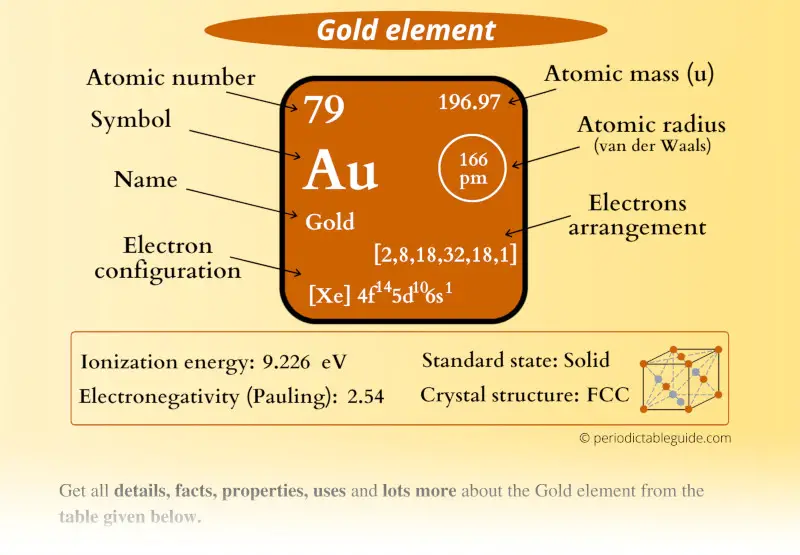
This is a SUPER easy guide on Gold element.
In fact, the table mentioned below is the perfect information box (Which gives you every single detail about the Gold element in Periodic table.)
So if you want to know anything about Gold element, then this guide is for you.
Let’s finish this very quickly.
Gold Element (Au) Information
| Appearance | 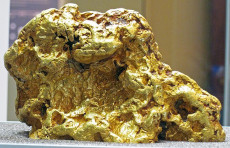 Metallic yellow |
| State | Solid |
| Position in Periodic table | 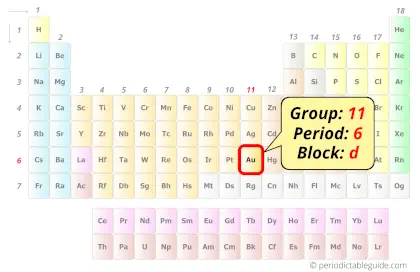 Group: 11, Period: 6, Block: d |
| Category | 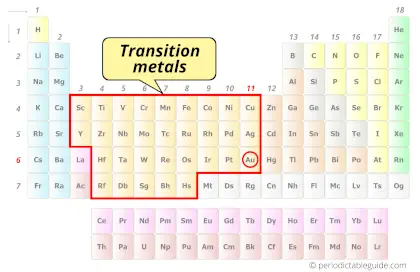 Transition metals |
| Atomic number or Protons | 79 |
| Neutrons | 118 |
| Electrons | 79 |
| Symbol | Au |
| Atomic mass | 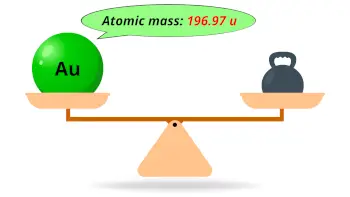 196.97 u |
| Electrons arrangement or Bohr model | 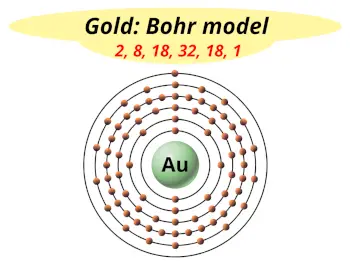 2, 8, 18, 32, 18, 1 |
| Electronic configuration | [Xe] 4f14 5d10 6s1 |
| Atomic radius | 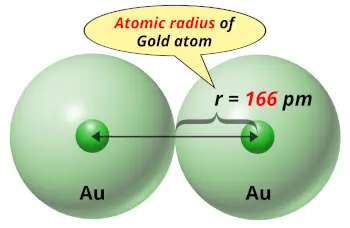 166 picometers (van der Waals radius) |
| 1st Ionization energy | 9.226 eV |
| Electronegativity | 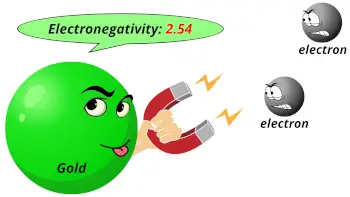 2.54 (Pauling scale) |
| Crystal structure |  FCC (face centered cubic) |
| Melting point | 1337 K or 1064 °C or 1947 °F |
| Boiling point | 3243 K or 2970 °C or 5378 °F |
| Density | 19.3 g/cm3 |
| Main isotope | 197Au |
| CAS number | 7440-57-5 |
Gold in Periodic table
Gold element is in group 11 and period 6 of the Periodic table. Gold is the d-block element and it belongs to transition metals group.
| H | He | ||||||||||||||||
| Li | Be | B | C | N | O | F | Ne | ||||||||||
| Na | Mg | Al | Si | P | S | Cl | Ar | ||||||||||
| K | Ca | Sc | Ti | V | Cr | Mn | Fe | Co | Ni | Cu | Zn | Ga | Ge | As | Se | Br | Kr |
| Rb | Sr | Y | Zr | Nb | Mo | Tc | Ru | Rh | Pd | Ag | Cd | In | Sn | Sb | Te | I | Xe |
| Cs | Ba | La* | Hf | Ta | W | Re | Os | Ir | Pt | Au | Hg | Tl | Pb | Bi | Po | At | Rn |
| Fr | Ra | Ac** | Rf | Db | Sg | Bh | Hs | Mt | Ds | Rg | Cn | Nh | Fl | Mc | Lv | Ts | Og |
| *Ce | Pr | Nd | Pm | Sm | Eu | Gd | Tb | Dy | Ho | Er | Tm | Yb | Lu | ||||
| **Th | Pa | U | Np | Pu | Am | Cm | Bk | Cf | Es | Fm | Md | No | Lr |
←Move to: Platinum (Pt) element – Periodic Table
→Move to: Mercury (Hg) element – Periodic Table
Why is Gold in Period 6?
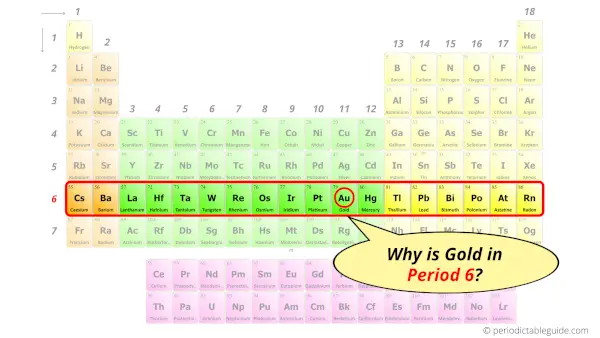
Let me ask you a question.
How many shells does a gold atom have?
It’s 6. Right?
You have already seen the bohr model of gold atom in the above table.
From the Bohr model, it can be found that the number of orbits or shells in gold is 6. Hence, as gold has 6 orbits, it lies in period 6 of the Periodic table.
Why is Gold in d-block?
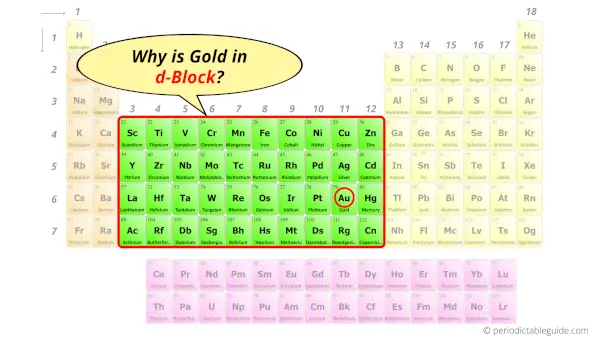
Before knowing this reason, first of all I want to ask you a simple question.
How can you determine the blocks-wise position of elements?
The simple answer: The elements will lie in the s, p, d or f block will completely depend upon the subshell in which the last electron will enter.
For example; the electron configuration of gold is [Xe] 4f14 5d10 6s1.
So the last electron of gold enters the d-subshell or d-orbital.
Hence, gold is the d-block element.
Is Gold a Transition Metal? Why?
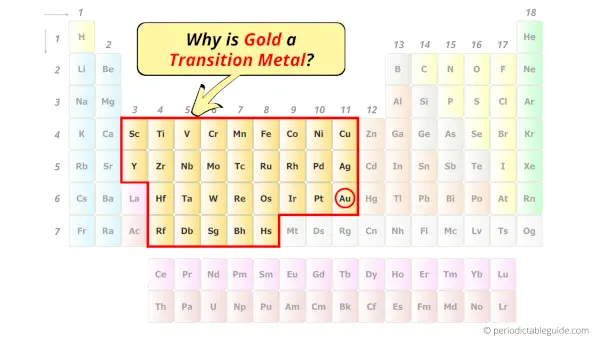
Yes, Gold is a transition metal because it has incompletely filled d-orbital in its common oxidation state (Au3+).
Let me explain the exact meaning of this.
According to the definition of transition metals;
The element should compulsorily have incomplete d-orbitals, either in their ground state (M) or most common oxidation states (M1+, M2+, etc) then only they are called transition metals.
Now, the ground state of gold means its normal state in which it has neither gained nor lost any electron/s (i.e Au).
And the common oxidation states of gold are Au+ and Au3+.
Now, let’s see the example of gold with oxidation state +3. So,
The electron configuration of Au is: [Xe] 4f14 5d10 6s1 and
The electron configuration of Au3+ is: [Xe] 4f14 5d9
So, in this +3 oxidation state of gold (Au3+), if we see the electron configuration, then it possesses incomplete d-orbitals.
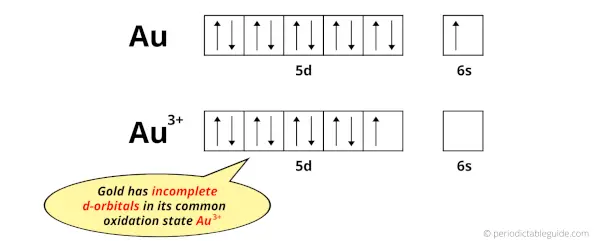
You can see that all the d-orbitals are completely filled (all the 10 electrons are present) in the elemental state (Au) but they are incomplete (only 9 electrons are present) in its oxidation state (Au3+).
In short, gold element have incomplete d-orbitals in its oxidation state (Au3+).
Hence, according to the definition mentioned above, gold is a transition metal.
5 Interesting facts about Gold
Interesting facts about gold element are mentioned below.
- The symbol of gold is Au, which came from the latin word for gold “aurum”.
- South Africa is the leading producer of gold and it produces around 2/3rd of the total gold production in the world.
- Approximately 78% of the total gold produced in the world goes to the manufacturing of jewelry.
- Gold is one of the elements that is known to humans since ancient times (before 6000 BCE).
- Apart from the earth’s crust, gold is also available from the oceans.
Properties of Gold
The physical and chemical properties of gold element are mentioned below.
Physical properties of Gold
Physical properties of gold are mentioned below.
- Gold is a precious metal having yellow metallic lustre.
- Gold is a ductile as well as malleable metal. Hence it can be drawn into thin wires as well as it can also be stretched into thin sheets.
- Gold is also a good conductor of heat and electricity.
- The atomic mass of gold is 196.97 u and its density is 19.3 g/cm3.
- The melting point of gold is 1064 °C and its boiling point is 2970 °C.
- Gold has many isotopes and out of the naturally occurring isotopes, 197Au is the most abundant (almost 100%).
- The crystal structure of gold is FCC (face centered cubic).
Chemical properties of Gold
Chemical properties of gold are mentioned below.
- Gold is a non reactive metal and it does not corrode or tarnish in the air.
- The oxidation states of gold range from -1 to +5. But the most common oxidation states of gold are +1 and +3.
- Gold does not react with oxygen even at higher temperature, but it does react with strong halogen like fluorine. Gold reacts with fluorine at higher temperature and forms gold (III) fluoride.
- At 180 °C, the powdered form of gold reacts with chlorine and forms AuCl3.
- Gold is not affected by most acids, but it dissolves in aqua regia (aqua regia is a mixture of nitric acid and hydrochloric acid).
Uses of Gold
Uses of gold are mentioned below.
- As gold is a precious metal, it is used in the manufacturing of jewelry and ornaments.
- In earlier days, gold was used in the manufacturing of gold coins (which was used as a currency).
- Gold is a very good conductor of electricity and it can conduct very small currents. Hence it is used in computers, mobile phones, as well as other electronics.
- Gold is also used in dentistry as it is inert metal, and it is nonallergic.
- Gold is highly malleable, due to which it is used in making very thin foil that can be applied on various shapes.
- Gold is also used in making medals and trophies for winners of the games.
Explore our New Interactive Periodic Table (with Rotating Bohr Models and More)

Details about this Periodic table:
- Access detailed info on all elements: atomic mass, electron configurations, charges, and more.
- View rotating Bohr models for all 118 elements.
- Get a free HD image of the Periodic Table.
Note: For future use, bookmark this Periodic table or visit “PeriodicTableGuide.com”
External resources:
- Gold – Element information, properties and uses | Periodic Table. (n.d.). Gold – Element Information, Properties and Uses | Periodic Table. https://www.rsc.org/periodic-table/element/79/gold
- Gold – Wikipedia. (2022, May 1). Gold – Wikipedia. https://en.wikipedia.org/wiki/Gold
- P. (n.d.). Gold | Au (Element) – PubChem. Gold | Au (Element) – PubChem. https://pubchem.ncbi.nlm.nih.gov/element/Gold
- It’s Elemental – The Element Gold. (n.d.). It’s Elemental – the Element Gold. https://education.jlab.org/itselemental/ele079.html
